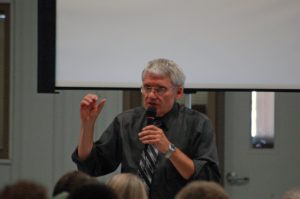One Third of Kewaunee County Still Has Tainted Water
- Share
- Tweet
- Pin
- Share

Tangled webs of bureaucracy are apparently the only thing keeping a third of Kewaunee County residents from having clean drinking water.
Well, that and the “massive regulatory failure” that has polluted the county’s waters, a situation first pointed out by Administrative Law Judge Jeffrey Boldt in November 2014, and very recently reiterated in an audit by the Legislative Audit Bureau that found major deficiencies in the Wisconsin Department of Natural Resources (DNR) wastewater/CAFO practices.

Russ Rasmussen. Photo by Jim Lundstrom.
Governmental impotence was the impression given to about 150 Kewaunee County residents who showed up for the June 23 meeting in Luxemburg to hear the recommendations from the workgroups that have been meeting to address the issue of tainted wells and groundwater in Kewaunee County. The report states that a third of private wells in the county are tainted with unsafe levels of nitrates and/or bacteria.
However, during a question and answer session after a formal presentation from Russ Rasmussen, of the Wisconsin DNR’s Division of Water, it quickly became apparent that none of the agencies responsible for ensuring clean water has the authority or political will to provide water to Kewaunee County residents living with tainted water.
“I would like to see a show of hands from people. How many would like to see water supplied today?” said Lynn Utesch, a Kewaunee County farmer, member of the group Kewaunee Cares and one of those who served on the Kewaunee County workgroups. “It’s time for the citizens to actually have clean water provided for them. No different from the city of Flint. We deserve that water.”
Utesch received loud and sustained applause for those remarks, certainly the loudest of the entire 2½-hour meeting.
Responding to Utesch’s call for the government to provide water to county residents, Tinka Hyde, director of the water division for EPA Region 5, said the difference is that Flint’s problem was a public water supply not private wells.
“The authority we have is quite limited,” she said, an argument she had to deliver several times throughout the night.

Lee Luft. Photo by Jim Lundstrom.
“I work in a world of rules, regulations and allocated budgets,” Hyde said. “With the clean drinking water act, I don’t have authority over private wells.”
“The EPA does not have authority,” began another of her answers to an audience question.
Yet several people, including Kewaunee County Supervisor and groundwater task force member Lee Luft, asked the EPA to stay involved in the county to keep the pressure on for compliance.
“My sense is if they leave and withdraw and assume that these recommendations will be implemented in a full and timely way would be a mistake,” Luft said. “So I am going to ask the EPA to live up to that commitment and stay here until they have seen this challenge through.”
“The EPA is committed to work with folks to find creative solutions to help facilitate moving forward,” Hyde said.
Algoma resident and workgroup member Dick Swanson reiterated a statement by a U.S. Department of Agriculture researcher regarding his surprise at seeing in Kewaunee County water quality that one would expect to see in a Third World country.
Jodi Parins, a workgroup member who serves on the Town of Lincoln Plan Commission, mentioned that one of the recommendations from the Short-Term Solutions workgroup was that the county budget $10,000 annually to provide clean drinking water to affected households.
“That recommendation has been out and about for at least the last three months,” she said. “I wonder if we can get that $10,000 and a process in place to get clean water to people immediately?”
The Groundwater Collaboration Workgroup Final Report is a 64-page document that includes “consensus” recommendations from four of the five workgroups that were formed to address the water contamination issues. The groups began meeting last August.
“I can tell you that reaching consensus on these issues was not easy to do,” said Rasmussen of the DNR.
In addition to the county buying drinking water for affected residents, the short-term solutions workgroup came up with 21 other recommendations, including making changes to the state’s well compensation program and having the DNR track contamination from affected wells to the source of contamination, at no cost to well owners.
The compliance workgroup came up with 14 recommendations, including adding DNR compliance staff positions, fill a currently vacant conservation warden position in the county, and more stringent review of CAFO emergency land spreading variances.
Rasmussen told the audience the DNR is in the process of hiring an environmental enforcement specialist dedicated to monitoring water quality in Kewaunee and Door counties.
The best management practices/sensitive areas workgroup came up with a series of 13 recommendations that farmers can voluntarily follow. The workgroup agreed to revisit the recommendations in a year to gauge their effectiveness. They include no mechanical applications of manure on soils with a soil depth less than 12 inches to bedrock and inspect fields for depth to bedrock and groundwater conduits.
The communications workgroup came up with 16 recommendations, including keeping the public informed of E. coli contamination and developing a communication plan for compliance and enforcement activities being conducted by the DNR.
A fifth workgroup named Alternative Technologies had its first meeting on June 23. The goal of this group will be to look into different farming methods and manure treatment technologies that would protect the county’s aquifer. This group will discuss new and established farming techniques.
To read the full report, visit dnr.wi.gov/topic/groundwater/collaborationworkgroup.html.

